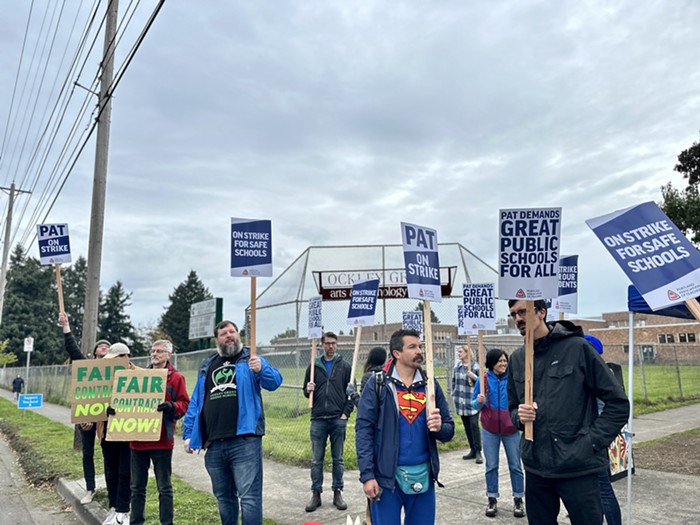WHEN STATE REPRESENTATIVE Alissa Keny-Guyer speaks to her constituents, the Eastside liberal has an easy time warming them to a concept that seems arcane at first: lifting the state's ban on inclusionary zoning.
Inclusionary zoning (IZ) ordinances require developers to set aside a certain number of housing units for lower- or middle-class incomes, so it's easy to see why Keny-Guyer's found an eager audience. Rising rents, rising housing prices, and a large homeless population have made it easy for the average Portlander to question whether the city is becoming a place for anyone other than the affluent.
The city's leaders are hoping to change that. Earlier this month, Portland City Council voted to study incentives that could lure developers into building more affordable housing in inner Portland. But the conversation in Salem these days involves a more-muscular approach.
Oregon is one of two states to outlaw IZ, and Democrats like Keny-Guyer are convinced that prevents municipalities from ensuring that lower- and middle-income people can afford a roof over their heads. They've been trying to lift the state ban ever since Republicans put it into place in 1999.
All Keny-Guyer has to tell a room is that Oregon shares its ban with only one other state—the very non-Oregon Texas—and she has people nodding in their seats.
Keny-Guyer and State Representative Jeff Reardon took up the IZ fight in the 2013 legislative session, following in the footsteps of former Representative Jefferson Smith, who tried unsuccessfully to get the ban repealed in 2011. All three legislators have represented significant swaths of East Portland, particularly beyond 82nd Avenue, where housing pressures have been particularly acute.
Like previous sessions, 2013's IZ repeal bill didn't go anywhere. So Reardon tried a new tack, bringing together a legislative work group of all the parties interested in housing. These ad-hoc committees are notorious in the Capitol as a way of talking an issue to death without quite killing it, but the freshman Reardon is eager for the challenge and optimistic about the group's promise.
"If you get people in a room and get their goals aligned, I think you can make things happen," Reardon says. He had assumed members of the group—which includes homebuilders and real estate agents, as well as housing nonprofits and affordable housing advocates—had been in regular communication. But he soon found out the parties, often on the opposite side of the issue, had never spoken.
Reardon also enlisted the help of Representative Julie Parrish, a West Linn Republican, to give the group the bipartisan stamp necessary for skeptical homebuilders and real estate agents to meet with the social justice groups.
Parrish opposes IZ and says it would backfire for its proponents, cutting into builders' bottom lines and discouraging them from putting up more housing. "It's not likely to go anywhere to say we're going to mandate affordable housing," she says.
Widely available in most states, IZ probably wouldn't cause the sky to fall—or be the silver bullet that proponents hope. Oregon is hardly the only state with a housing crisis. California communities have long required builders to provide affordable housing units, yet the state's housing problem outstrips Oregon's.
Rather than waste effort trying to push through legislation, Parrish suggests the group could expand its vision of what's possible. She supports ideas such as waiving development fees associated with affordable housing, with the state offsetting that lost money with grants.
Such incentives are at the heart of Portland's current conversation around affordable housing. Commissioner Dan Saltzman, Portland's housing commissioner, says we need to study so-called "incentive zoning" in an effort to beef up options in the city. Portland rents have increased by more than 11 percent in the last year, he says, while income has stayed flat.
"We are at a tipping point," Saltzman said at a city council meeting on May 7. "Will we become the next San Francisco, where you have the rich and poor, and nothing in between?"
Today, both houses in Oregon's legislative assembly are controlled by IZ-friendly Democrats, but that majority is a bit of an illusion; while House Majority Leader Val Hoyle, D-Eugene, has proven capable of marshalling progressive legislation through her chamber, the Democrats' minimal 16-14 majority in the Senate gives veto power to conservative Democrat Betsy Johnson of Scappoose, who's well known for crushing the dreams of liberals.
If the Democrats pick up seats in the Senate in November's election, it could be a whole new ballgame. But if the makeup stays the same, or if they lose seats in the House, expect the status quo.
The legislative work group seeks to find common ground on IZ, a tough proposition. "It's divisive and we're not going to reach consensus on that," says Janet Byrd, the executive director of Portland's Neighborhood Partnership Fund and a leader of the work group. "It could easily come up separately from this work group."
Byrd said other topics are also likely off limits, such as making any grand alterations of Oregon's restrictive and conservation-minded land-use laws. But the rules developers face could be clarified.
Also unlikely to reach consensus: the suspension of prevailing wage laws, which encourage union labor, ensuring the people who build the houses are fairly paid, but inflating the cost according to some.
One idea that Byrd said was popular across the table was setting up the groundwork for a marketplace where the construction of smaller units—from tiny 80-square-foot micro-houses to efficiency apartments to classic 800-square-foot American bungalows— might be feasible.
Today in Portland, it's difficult to find a homebuilder willing to put up a house smaller than 1,600 square feet, according to Byrd, and most serve up houses much larger than that, even as the average family size has shrunk dramatically.
Sometimes, government has been the problem. Restrictive ordinances in towns like Salem prohibit building modest houses below a certain square footage. But even where such policies don't stand in the way, market forces may not be enough to shift construction and home buying away from the bigger-is-better mentality that epitomized the Bush-era housing bubble.
Builders and their lenders need faith that people will actually buy smaller houses. The overhead costs of building a smaller home can be nearly as high as a larger one. The government can step in with financial incentives and loan guarantees where the current blend of market forces and government regulations has failed.
And if the government has any hand in helping home construction, it can set the rules.
"If the state is providing a benefit," Byrd says, "the state can expect a public good in return."



















